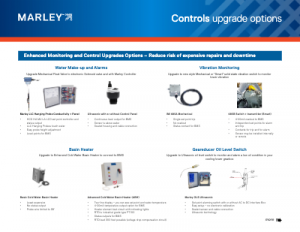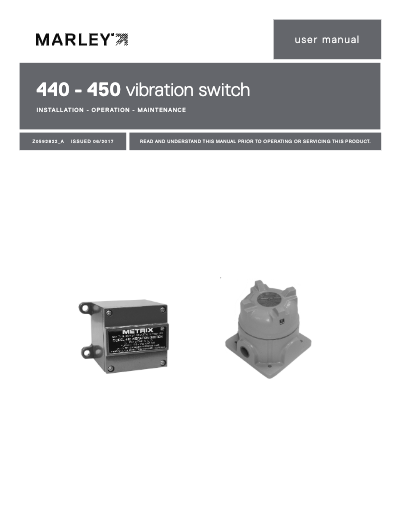Vibration Switches
Overview
Cooling tower vibration switches trigger an alarm and/or shut down equipment when excessive vibration occurs. A variety of options are available, from simple mechanical switches to “smart” switches. SPX Cooling Tech provides the following switch types, each with varying levels of sophistication, which can help monitor and protect cooling tower components from potentially destructive effects of vibration.
The mechanical vibration switch is the most cost-effective option for cooling tower vibration management. However, it is often the least accurate and least reliable option. The mechanical switch comprises an inertia-sensitive mechanism that activates a snap-action switch if vibration exceeds a specified set point. The switch, when “tripped,” can simultaneously trigger an alert and shut down the equipment. Because these switches do not collect data, they are able only to react to a vibration event as it is occurring. In many cases this is too late to prevent a failure; the only thing the mechanical switch prevents is further damage to the tower.
Electronic Vibration Switch
The electronic vibration switch for cooling tower vibration management has several advantages over a mechanical switch. The electronic switch utilizes a solid-state piezoelectric crystal to provide a 4-20mA electrical output when deformed by vibration forces. Vibration that exceeds a preset limit triggers an alarm, alerting operators to inspect the cooling tower and shut it down before failure occurs. If vibration exceeds a second preset limit before operators manually shut down the tower, the switch triggers a solid-state relay for automatic shutdown. Both the mechanical and electronic switches typically are mounted on structural support beams. Alternately, the electronic switch offers an external accelerometer option which provides superior vibration measurement accuracy when mounted on the casing of the gearbox.
“Smart” Vibration Switch
The “smart” vibration switch for cooling tower vibration management offers many of the advantages of an electronic vibration switch. The smart switch measures vibration with an imbedded piezoelectric accelerometer. Its small footprint and hermetically sealed casing allow installation directly onto the gearbox or bearing housing and does not require an additional external accelerometer. Smart switches offered by SPX feature factory-programmed set points, start-up delays, and alarm delay timers specifically optimized for cooling tower vibration protection.
| Vibration Management Options for Cooling Towers | |||||
| Options | Metrix 5550 (Mechanical) |
IMI 685A (Mechanical) |
Metrix 440/450 (Electronic) |
IMI 685B (Electronic) |
IMI 686B (Smart) |
|---|---|---|---|---|---|
| Relative Cost | $ | $ | $$$$ | $$$$ | $$ |
| Method of Measurement | inertia | inertia | velocity | velocity | velocity |
| Mounting Method | on structural support | on structural support | on structural support (ext. accelerometer recommended) | on structural support (ext. accelerometer recommended) | on gearbox or bearing housing |
| Vibration / Amplitude Range | 0–16g pk | 0–7g pk | 0.1–1.5 in/s | 0.1–1.5 in/s | 0.25–5.0 in/s |
| Frequency Range | 0–60Hz (0–3,600cpm) | 0–100Hz (0–6,000cpm) | 2–1,000Hz (120-60,000cpm) | 2–1,000Hz (120-60,000cpm) | 2–1,000Hz (420-60,000cpm) |
| Set Point | 1–2g (recommended) | 1–2g (recommended) | 0.6 in/s (alarm) 0.7 in/s (shutdown) |
0.6 in/s (alarm) 0.7 in/s (shutdown) |
0.6 in/s (alarm) (SPX factory setting) |
| Output Signal | n/a | n/a | 4–20mA (opt) | 4–20mA (std) | n/a |
| Power Input | n/a | n/a | 100–130 VAC | 85–245 VAC | 24–240 VAC |
| Relay Contact Options | SPDT, silver (std) DPDT, gold (opt) |
2 x SPDT (DPDT) form C |
(1 or 2) x SPDT form C, silver |
2 x SPDT form C relay, or SPST triac |
SPST MOSFET form A, or form B |
| Relay Contact State | open or closed | open or closed | open or closed | open or closed | normally closed (SPX factory setting) |
| Wiring Entries | 3/4” NPT or M20 x 1.5 |
3/4”–14 NPT | 1 x 3/4” NPT [440] 2 x 3/4” NPT [450] |
cord grips or 1/2” NPT |
30 ft integral cable |
| Reset Options | ext. push-button std, remote reset opt |
ext. push-button std, remote reset opt |
ext. push-button or remote reset, auto reset configurable |
int. push-button std, remote reset opt |
cycle power for reset |
| Tower Start-Up Time Delay | 20–30 sec (requires remote reset) | not standard (timer required in customer start circuit) | optional, factory set at 20 sec (non-adjustable) | 20 sec | 5 sec (SPX factory setting) |
| Alert/Alarm Time Delay | n/a | n/a | 3 sec (SPX factory setting) | 0–45 sec | 3 sec (SPX factory setting) |
| Housing Material | copper-free cast aluminum | aluminum alloy with epoxy | copper-free aluminum, zinc chromate & epoxy | aluminum alloy | hermetically sealed stainless steel |
| Environmental Rating | NEMA 4/IP66 (std), NEMA 4X/IP66 (opt) |
NEMA 4X/IP66 | NEMA 4X | NEMA 4X/IP66 | NEMA 4X/IP68 |
| Manufacturer Site | metrixvibration.com | pcb.com | metrixvibration.com | pcb.com | pcb.com |
All factory-programmed and tested
Sophisticated options measure and analyze vibration
Sophisticated options hermetically sealed















